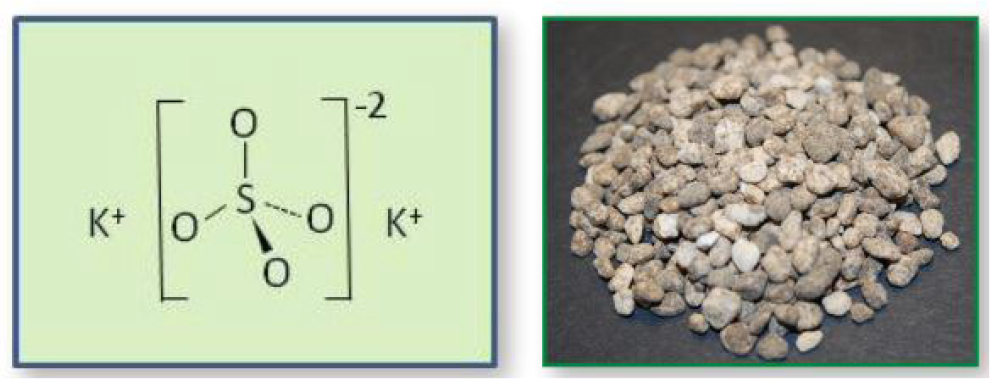⇦ Back to Fertilizer Lime Amendment Technology and Use Home
¶ Introduction
Most fertilizer potassium comes from ancient salt deposits located throughout the world. The word “potash” is a general term that most frequently refers to potassium chloride (KCl). It also applies to all other potassium-containing fertilizers, such as potassium sulfate (K2SO4) , commonly referred to as “sulfate of potash (SOP)”.
¶ Production
Potassium is a relatively abundant element in the Earth’s crust and production of potash fertilizer occurs in every inhabited continent. Potassium sulfate is rarely found in a pure form in nature. It is naturally mixed with salts containing magnesium, sodium, and chloride. These minerals require additional processing to separate their components.
Potassium sulfate has been historically produced made by reacting potassium chloride with sulfuric acid. It was later discovered that a number of earth minerals could be manipulated to produce potassium sulfate. This is now the most common method of production.
For example, natural potassium-containing minerals (such as kainite and schoenite) are mined and carefully rinsed with water and salt solutions to remove byproducts and produce potassium sulfate.
A similar process is used to harvest potassium sulfate from the Great Salt Lake in Utah, and from underground mineral deposits. In New Mexico, potassium sulfate is separated from langbeinite minerals by reacting it with a solution of potassium, which removes the byproducts (such as magnesium) and leaves potassium sulfate.
Similar processing techniques are used in many parts of the world, depending on the raw materials accessible.
¶ Table 1. |
|
| Chemical formula | K2SO4 |
| Fertilizer analysis | 48% – 53% K2O |
| 17% – 18% sulfur | |
| Water solubility @ 68°F | 120 g/L |
| Solution pH | ≈ 7 |
¶ Agricultural Use
The potassium portion of the potassium sulfate is no different than other common potash fertilizers. It also supplies a valuable source of sulfur, which is sometimes deficient for plant growth. Sulfur is required for protein synthesis and enzyme function.
There are certain soils and crops where the addition of chloride should be avoided. In these cases, potassium sulfate makes a very suitable potassium source.
Potassium sulfate is only one-third as soluble as potassium chloride, so it is not as commonly dissolved for addition through irrigation water unless there is a need for additional sulfur.
Several particle sizes are commonly available. Fine particles (<0.015 mm) dissolve more rapidly, so are used for making solutions for irrigation or foliar sprays. Leaf damage can occur if the concentration is too high.
¶ Figure 1. Potassium Sulfate Form

¶ Management Practices
Potassium sulfate is frequently used for crops where the additional chloride from potassium chloride fertilizer is undesirable. The partial salt index of potassium sulfate is lower than some other common potassium fertilizers, so less total salinity is added per unit of potassium. The salt measurement (as electrical conductivity) from a potassium sulfate solution is less than a third of a similar concentration of a potassium chloride solution (at 10 mmol/L).
Where high rates of potassium sulfate are needed, it is generally recommended to divide the application into multiple doses. This helps avoid surplus potassium accumulation by the plant and also minimizes any potential salt damage.
¶ Non-agricultural Use
Potassium sulfate is used occasionally in the manufacture of glass, as a flash reducer in artillery propellant charges, and in pyrotechnics in combination with potassium nitrate to generate a purple flame.
¶ References
IPNI. Nutrient Source Specifics No. 5: Potassium Sulfate. International Plant Nutrition Institute, Norcross Georgia. 1 pg.